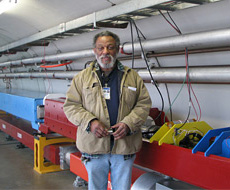Cahill has front-row seat to growth in lab, technology
 |
| KC Cahill helped build the Tevatron accelerator magnets similar to these displayed on the 15th floor of Wilson Hall. |
When Cutchlow Cahill was a child, he used to accompany his father on electrician jobs, so when Fermilab put out a call for electricians to construct a chain of accelerators, he jumped at the opportunity. That was in 1969.
Cahill, who celebrates 40 years working at Fermilab this week, is the only remaining employee from the Training and Development program that recruited African-Americans from Chicago to work as mechanical and electronic technicians.
He has had a hand in nearly every growth spurt of the laboratory. He originally helped build the beam position detectors, radio frequency amplifiers and RF cavities. Today he works in the cryogenics control room, monitoring the ethane gas, liquid nitrogen and liquid helium levels. Tour the CDF building with Cahill, known as KC, and he’ll show you where he takes inventory of helium and nitrogen bottles, sends out ethane gas to test it for impurities and silences alarms on his computer screen for cryogenic monitoring and operating equipment.
Cahill considers himself fortunate to have contributed to Fermilab’s progress. “Since I’ve been here, I’ve witnessed the goal of gaining beam intensity,” he said. “I get a good feeling when I see pieces of equipment that I helped make.”
Helping is something that comes naturally to KC.
“You can call him at any time in the night. He’s one of those people who has a hard time saying ‘no,’” said PPD technical supervisor Curtis Danner, who has known and worked on and off with Cahill since 1970. Whether it’s fixing friends’ or co-workers’ cars in the middle of the night, or repairing an air pressure regulator at CDF, Cahill has helped many people at Fermilab during his 40-year tenure.
“I know how to do a lot of things,” he said.
In the rare moments when KC took a break from work, he played basketball and was once a member of Fermilab’s now defunct team “the Protons.”
--Kristine Crane
|